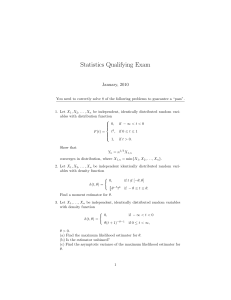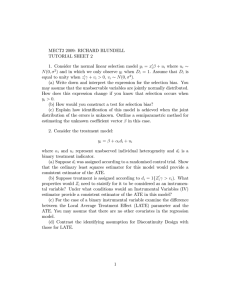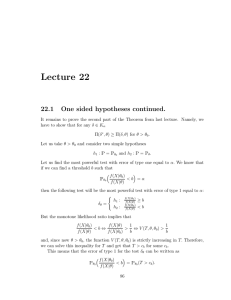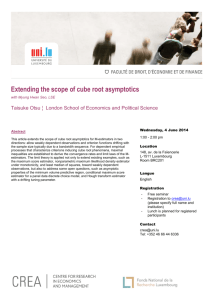Statistics Qualifying Examination January 7, 2009
advertisement
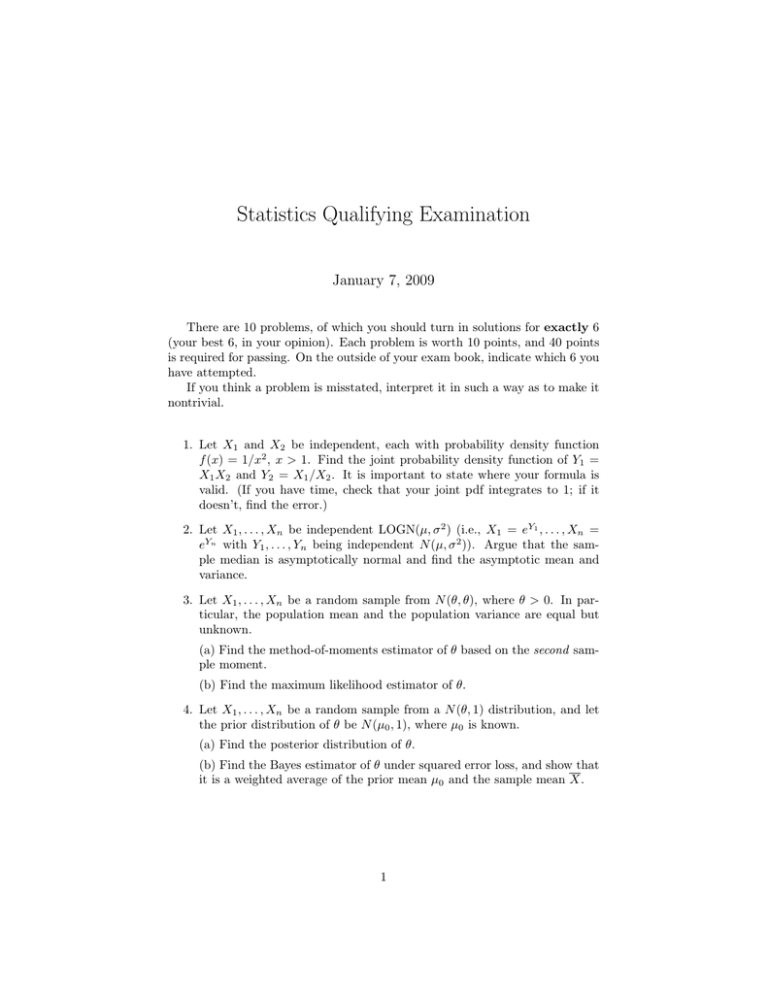
Statistics Qualifying Examination January 7, 2009 There are 10 problems, of which you should turn in solutions for exactly 6 (your best 6, in your opinion). Each problem is worth 10 points, and 40 points is required for passing. On the outside of your exam book, indicate which 6 you have attempted. If you think a problem is misstated, interpret it in such a way as to make it nontrivial. 1. Let X1 and X2 be independent, each with probability density function f (x) = 1/x2 , x > 1. Find the joint probability density function of Y1 = X1 X2 and Y2 = X1 /X2 . It is important to state where your formula is valid. (If you have time, check that your joint pdf integrates to 1; if it doesn’t, find the error.) 2. Let X1 , . . . , Xn be independent LOGN(µ, σ 2 ) (i.e., X1 = eY1 , . . . , Xn = eYn with Y1 , . . . , Yn being independent N (µ, σ 2 )). Argue that the sample median is asymptotically normal and find the asymptotic mean and variance. 3. Let X1 , . . . , Xn be a random sample from N (θ, θ), where θ > 0. In particular, the population mean and the population variance are equal but unknown. (a) Find the method-of-moments estimator of θ based on the second sample moment. (b) Find the maximum likelihood estimator of θ. 4. Let X1 , . . . , Xn be a random sample from a N (θ, 1) distribution, and let the prior distribution of θ be N (µ0 , 1), where µ0 is known. (a) Find the posterior distribution of θ. (b) Find the Bayes estimator of θ under squared error loss, and show that it is a weighted average of the prior mean µ0 and the sample mean X. 1 5. Let X1 , . . . , Xn be a random sample from Poisson(θ). (a) Find a complete, sufficient statistic. (b) Noting that Pθ (X1 = 1) = θe−θ , use the Rao–Blackwell and Lehmann– Scheffé theorems to find a UMVUE of τ (θ) := θe−θ . 6. Assume a sample of size n from UNIF[η −θ, η +θ], which is a location-scale family. Here η is real and θ > 0. (a) Find a 100(1 − α)% confidence interval for θ. (b) Find a 100(1 − α)% confidence interval for η. It is not necessary to find the explicit distribution of the pivotal quantities; just denote the needed quantiles by xp and yp for an appropriate p. 7. Let X1 , . . . , Xn be a random sample from UNIF[0, θ]. Find the UMP test of size α of H0 : θ ≥ θ0 vs. Ha : θ < θ0 by first deriving a most powerful test of simple hypotheses and then extending it to composite hypotheses. 8. Let X1 , . . . , Xn be a random sample from N (µ, σ02 ), where σ02 is known. Find the generalized likelihood ratio test of size α of H0 : µ ≥ µ0 vs. Ha : µ < µ0 . 9. According to a genetic model the proportions of individuals having the four blood types should be given by O: q 2 ; A: p2 + 2pq; B: r2 + 2qr; AB: 2pr. Here p > 0, q > 0, r > 0, and p + q + r = 1, but the three parameters are unknown. We observe nO , nA , nB , nAB individuals of the four blood types in a random sample of size n. Describe a goodness-of-fit test of size α of the stated hypothesis. 10. Consider the simple linear regression model Yi = β0 + β1 xi + εi (i = 1, 2, . . . , n). Assume independent N (0, σ 2 ) errors. (a) Find the least squares estimators β̂0 of β̂1 of β0 and β1 . (b) Calculate the covariance matrix of (β̂0 , β̂1 ). 2




